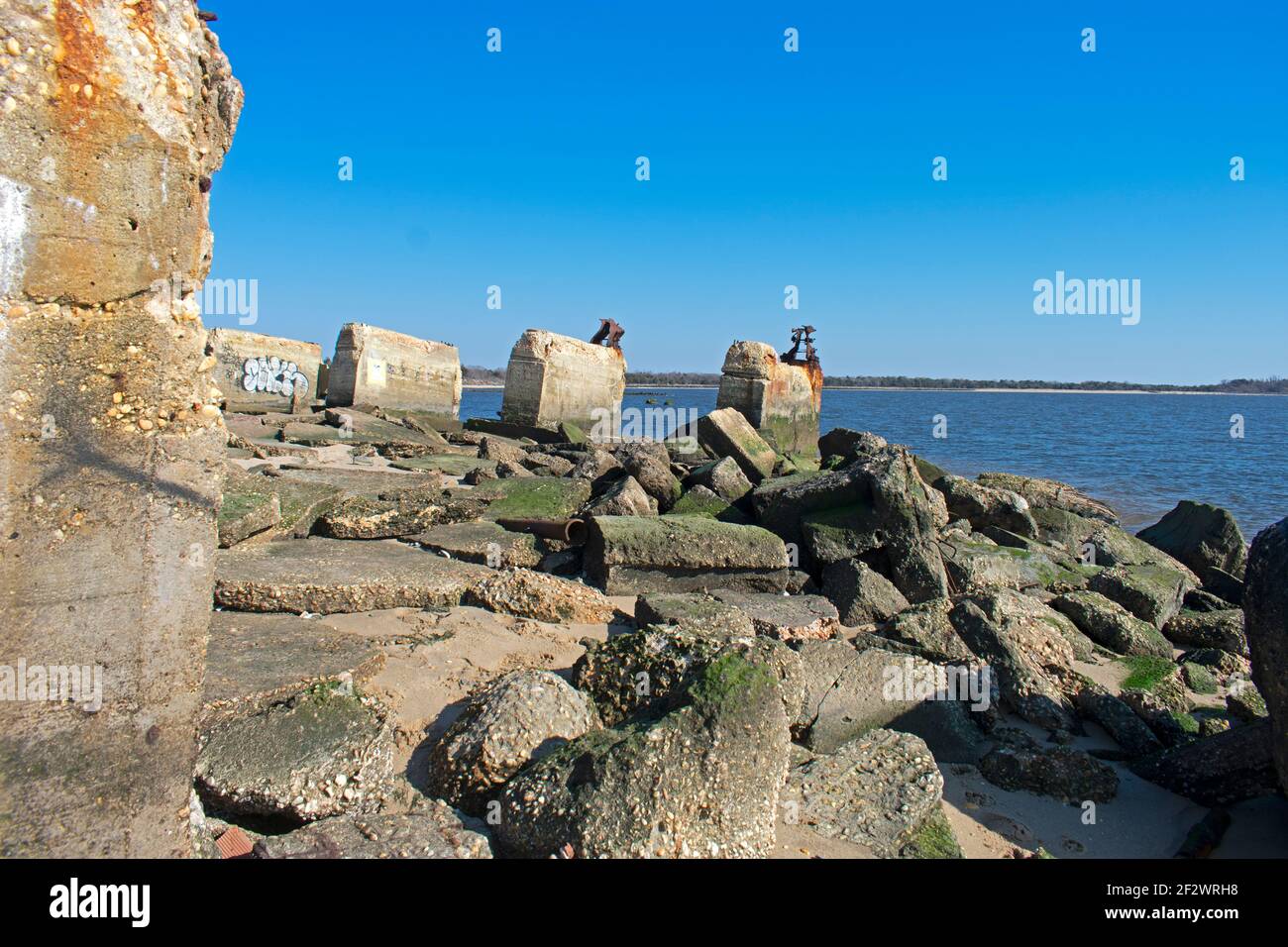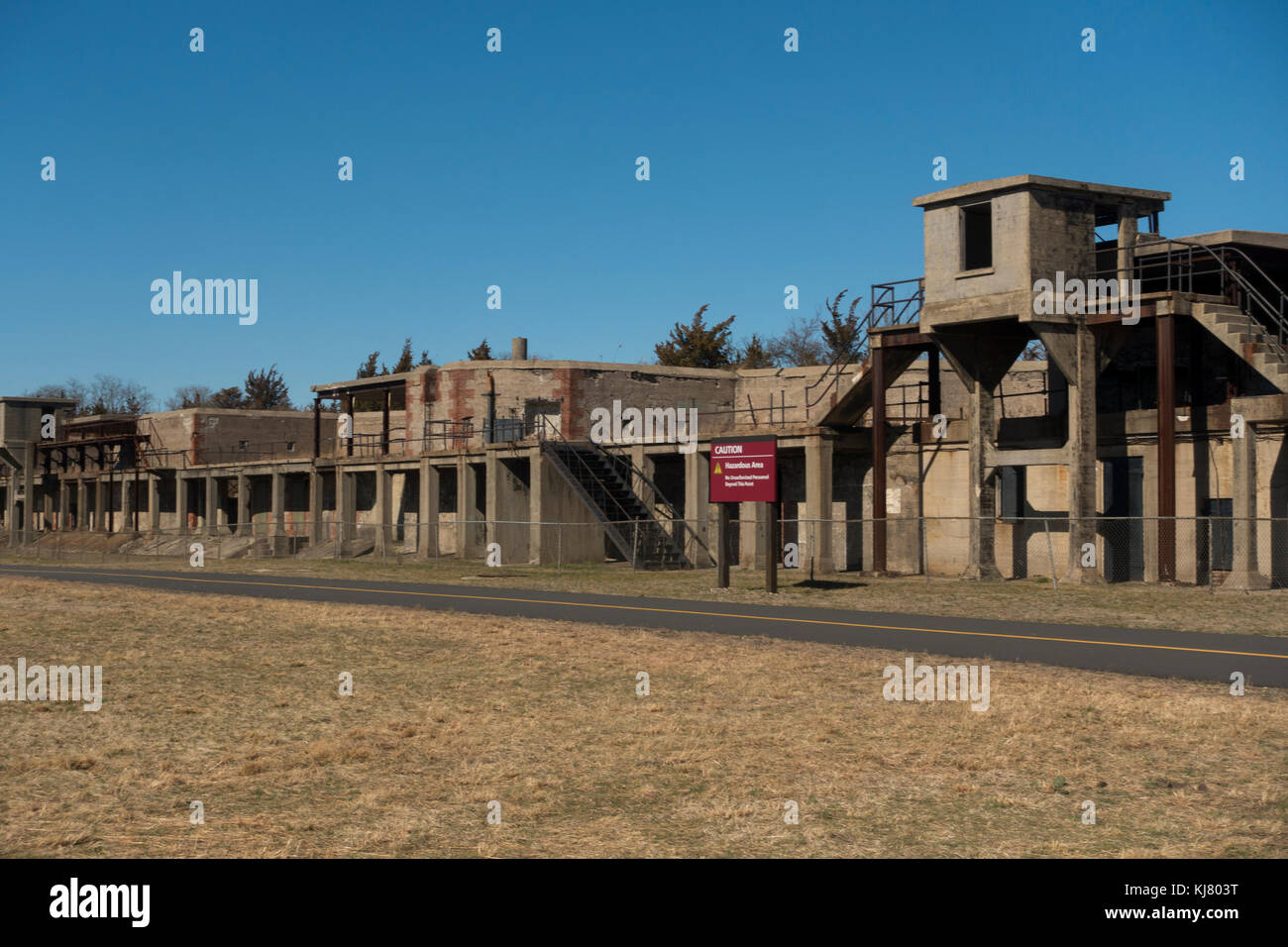
Echoes of Empire: The Haunting Beauty of Fort Hancock, New Jersey
Perched at the northern tip of New Jersey’s Sandy Hook peninsula, a slender finger of land reaching out into the churning Atlantic, Fort Hancock is a place where history whispers through crumbling walls and salt-laced air. It’s a paradox: a formidable military fortress designed to protect the very heart of America, now a hauntingly beautiful "ghost town" within the embrace of Gateway National Recreation Area. Its decaying grandeur, set against the backdrop of pristine beaches and the iconic Sandy Hook Lighthouse, tells a compelling story of ambition, obsolescence, and the relentless march of time.
To step onto the grounds of Fort Hancock today is to enter a liminal space. Grand Victorian officers’ homes stand vacant, their windows shattered like vacant eyes, paint peeling from their once-elegant facades. Further in, colossal concrete gun batteries, designed to repel invading navies, lie silent and overgrown, their massive emplacements now playgrounds for photographers and history buffs. The sense of a forgotten world, abruptly abandoned, is palpable, creating an almost eerie, yet profoundly captivating, atmosphere.

A Strategic Sentinel: Birth of a Fortress
The strategic importance of Sandy Hook has been recognized since colonial times. Guarding the entrance to New York Harbor, one of the world’s busiest and most vital waterways, it was a natural choke point. Early fortifications existed, but it was in the late 19th century, following the recommendations of the Endicott Board (1885), that Fort Hancock truly began to take shape as a modern coastal defense installation. Named for Major General Winfield Scott Hancock, a distinguished Civil War commander, the fort was commissioned in 1895.
The Endicott Period marked a revolution in American coastal defense. Gone were the brick and mortar fortresses of the past, replaced by massive concrete and steel emplacements designed to house disappearing guns – artillery pieces that would retract behind thick walls after firing, protecting them from enemy counter-fire. Fort Hancock became home to some of the most advanced weaponry of its time, including 12-inch and 10-inch disappearing guns, mortar batteries, and rapid-fire guns. Batteries like Potter, Gunnison, and King stand as colossal monuments to this era, their sheer scale a testament to the nation’s determination to protect its vital interests.
"Fort Hancock represents a crucial chapter in America’s coastal defense strategy," explains Dr. Sarah Miller, a military historian who has studied the site extensively. "It was part of a nationwide network, but its proximity to New York City made it uniquely vital. The technology of these Endicott batteries was cutting-edge; they were designed to deter any naval threat, and for a long time, they did exactly that."
Life Behind the Walls: A Self-Contained World
Fort Hancock wasn’t merely a collection of formidable armaments; it was a living, breathing community. During its peak, thousands of soldiers and their families called it home. The post developed into a self-contained town, complete with officers’ quarters (a majestic row of Victorian and Colonial Revival homes known as "Officers’ Row"), enlisted barracks, a hospital, a chapel, a post office, a fire station, a mess hall, a gymnasium, and even a movie theater. Children attended school on post, and families built lives around military routines and the unique isolation of the peninsula.
"It was a vibrant community, a world unto itself," recalls Eleanor Vance, whose father was stationed at Fort Hancock in the 1950s. "We had dances at the gym, picnics on the beach, and the camaraderie was incredibly strong. You were part of something bigger, protecting the country. But also, you were just living your life, riding bikes, going to school, like anywhere else, just with big guns in the background."
Through two World Wars, Fort Hancock played its part, though largely as a silent deterrent. Its guns were never fired in anger against an invading force. However, it served as a training ground, a logistics hub, and a vital component of the nation’s readiness.

The Cold War and Obsolescence
The post-World War II era brought dramatic shifts in military technology. The advent of long-range bombers and, more significantly, intercontinental ballistic missiles rendered fixed coastal defenses largely obsolete. The colossal gun batteries that once defined Fort Hancock became relics overnight.
Yet, Fort Hancock found a new purpose during the Cold War. From 1957 to 1974, it served as a Nike missile base (specifically, site HM-69), part of a ring of anti-aircraft missile batteries protecting the New York metropolitan area from Soviet air attack. Concrete pads and underground bunkers, a stark contrast to the earlier architectural styles, emerged on the peninsula, housing the guided missiles that represented the cutting edge of Cold War defense.
This dual history – from massive gun emplacements to the sleek, modern (for their time) Nike missiles – makes Fort Hancock a unique repository of American military evolution. It showcases the rapid technological advancements that transformed warfare in the 20th century.
The Abrupt Silence: From Base to Ghost Town
The end came swiftly. In 1974, with the Nike program winding down and the strategic landscape fundamentally altered, Fort Hancock was officially decommissioned. The military presence, which had shaped the peninsula for nearly a century, vanished. The land and its buildings were transferred to the National Park Service (NPS) to become part of the newly established Gateway National Recreation Area.
When the last soldiers departed, many buildings were simply locked up, their contents left behind. Desks, chairs, even personal effects, were often abandoned. This immediate cessation of activity created the "ghost town" effect so striking today. Without a dedicated purpose or occupants, the elements began their relentless work. Windows shattered, roofs collapsed, and vegetation began to reclaim the manicured lawns and parade grounds. Vandalism, though curtailed over time, also took its toll.
"Walking through Fort Hancock today, you can almost hear the echoes of the past," observes Robert Jenkins, a photographer who frequently captures the fort’s decaying beauty. "It’s a place where time seems to have stopped, a raw, unfiltered look at abandonment. The peeling paint, the broken glass, the way nature is slowly reasserting itself – it’s incredibly powerful and melancholic."
A Race Against Time: Preservation and Renewal
The National Park Service, inheriting this sprawling relic, faced a monumental challenge. How do you preserve a complex of over 100 historic buildings, many of which are deteriorating rapidly, while also maintaining the natural beauty of a barrier island and providing public access? The cost of rehabilitation is astronomical, far exceeding available federal funding.
"It’s a race against time," admits a park ranger, who requested anonymity due to ongoing policy discussions. "Every storm, every harsh winter, takes a toll. We have limited resources, and we have to make difficult choices about what we can stabilize, what we can restore, and what we simply have to let succumb to nature."
In an innovative approach, the NPS launched a leasing program, offering long-term leases on many of the historic buildings to individuals and organizations willing to undertake the costly rehabilitation and maintenance. The idea is to bring life back to the fort, transforming the vacant structures into residences, businesses, or cultural centers, while adhering to strict historic preservation guidelines.
Progress has been slow but steady. Some officers’ houses have been beautifully restored and are now private residences, their lights once again flickering at dusk. The historic chapel has been renovated and hosts weddings and events. Battery Gunnison, one of the Endicott era batteries, has been restored and offers living history programs, allowing visitors to experience what the fort was like in its prime. The Sandy Hook Lighthouse, the oldest operating lighthouse in the United States, stands proudly beside the fort, a beacon of continuous history.
However, many buildings remain vacant, silent testaments to the scale of the challenge. Hurricane Sandy in 2012 dealt a significant blow, inundating parts of the fort and causing further damage, setting back preservation efforts by years.
Enduring Allure: A Sentinel in Decline
Despite the decay, or perhaps because of it, Fort Hancock’s allure endures. It draws history enthusiasts eager to explore its formidable batteries and contemplate its past. It attracts photographers captivated by its stark beauty, the interplay of light and shadow on crumbling concrete, and the vibrant colors of rust against the muted tones of decay. Nature lovers flock to Sandy Hook for its pristine beaches, birdwatching opportunities, and unique maritime forest, often stumbling upon the fort as a bonus.
Fort Hancock is a paradox: a place of immense military power now quietly succumbing to the elements. It serves as a potent reminder of the fleeting nature of human endeavors and the enduring power of nature. In its quiet decline, it remains a powerful sentinel, not of military might, but of history itself, offering a tangible connection to a bygone era and prompting contemplation on the cycles of creation, abandonment, and rebirth. It is a place that truly speaks, if you take the time to listen, to the echoes of empire.


